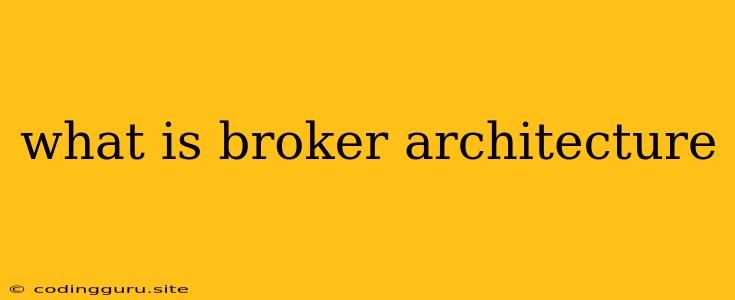What is Broker Architecture?
Broker architecture is a crucial concept in software design, especially in the realm of distributed systems. It forms the backbone of communication and data exchange between different parts of an application. Understanding broker architecture is essential for building robust, scalable, and efficient applications.
But what exactly is broker architecture?
Imagine a bustling marketplace where numerous vendors and buyers interact. A broker, situated at the heart of this marketplace, acts as an intermediary, facilitating transactions between these parties. They receive requests from buyers, relay them to the appropriate vendors, and then deliver the responses back.
This is precisely what a broker architecture does in software development. It's a central component that acts as a mediator, handling communication between various parts of an application, services, or even external systems. This architecture pattern allows for:
- Loose Coupling: Components can be developed and deployed independently without being tightly bound to each other.
- Scalability: The broker can handle increasing workloads by adding more resources or instances.
- Flexibility: It allows for easy integration of new components or systems without affecting existing ones.
- Resilience: By isolating communication, the failure of one component doesn't necessarily bring the entire system down.
Types of Broker Architectures
There are several popular types of broker architectures, each with its own advantages and disadvantages:
1. Message Queue:
- Concept: A message queue broker acts as a temporary storage for messages sent by producers and consumed by consumers.
- How it works: Producers send messages to the queue, and consumers pull messages from the queue to process them. This asynchronous communication allows for decoupling of producers and consumers, enabling them to operate independently.
- Example: RabbitMQ, Apache Kafka, Amazon SQS
2. Publish/Subscribe:
- Concept: A publish/subscribe broker allows producers to publish messages to specific topics, and consumers subscribe to those topics to receive messages.
- How it works: Producers publish messages to designated topics, and consumers subscribe to those topics to receive only relevant messages.
- Example: MQTT, Apache Kafka, Redis Pub/Sub
3. Request-Response:
- Concept: A request-response broker facilitates synchronous communication between clients and services.
- How it works: Clients send requests to the broker, which forwards them to the appropriate services. The broker then receives responses from services and relays them back to the clients.
- Example: REST APIs, gRPC
Advantages of Broker Architecture
- Decoupling: Components can be developed and deployed independently, leading to greater flexibility and maintainability.
- Scalability: The broker can handle increasing workloads by adding more resources or instances, ensuring the system remains performant.
- Resilience: The broker isolates communication, meaning the failure of one component doesn't necessarily impact the entire system.
- Asynchronous Communication: Message queues and publish/subscribe systems enable asynchronous communication, improving system performance and allowing for more efficient resource utilization.
Disadvantages of Broker Architecture
- Complexity: Introducing a broker can increase system complexity, requiring additional infrastructure and configuration.
- Single Point of Failure: The broker itself becomes a single point of failure; if it fails, the entire communication system collapses.
- Performance Overhead: Message serialization, network communication, and broker processing can introduce some overhead, affecting overall system performance.
Choosing the Right Broker Architecture
Selecting the appropriate broker architecture depends on various factors, including the specific requirements of your application:
- Nature of Communication: Is it synchronous (request-response) or asynchronous (message queues, pub/sub)?
- Data Volume and Frequency: How much data needs to be exchanged, and how frequently?
- Scalability Needs: How will the system grow in the future?
- Reliability and Availability: What are the criticality and tolerance for downtime?
Conclusion
Broker architecture provides a valuable framework for building robust, scalable, and flexible distributed systems. By understanding the different types, advantages, and disadvantages, developers can choose the most appropriate broker architecture to address the specific needs of their application. This choice can significantly impact the performance, scalability, and reliability of your system.
